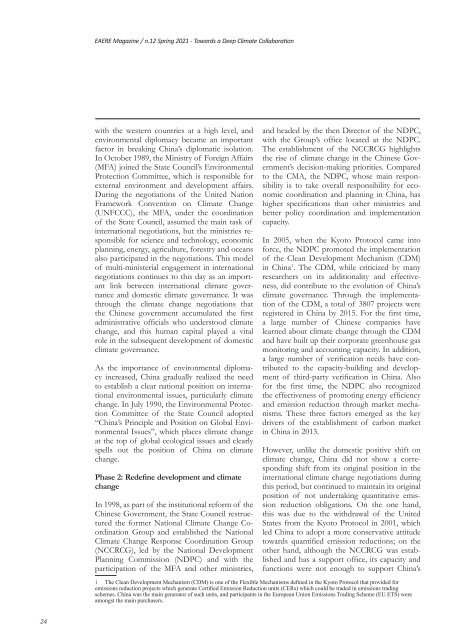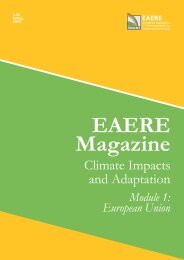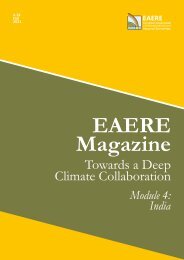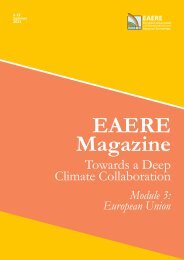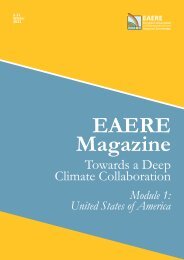Create successful ePaper yourself
Turn your PDF publications into a flip-book with our unique Google optimized e-Paper software.
<strong>EAERE</strong> <strong>Magazine</strong> / n.12 <strong>Spring</strong> <strong>2021</strong> - Towards a Deep Climate Collaboration<br />
with the western countries at a high level, and<br />
environmental diplomacy became an important<br />
factor in breaking China’s diplomatic isolation.<br />
In October 1989, the Ministry of Foreign Affairs<br />
(MFA) joined the State Council’s Environmental<br />
Protection Committee, which is responsible for<br />
external environment and development affairs.<br />
During the negotiations of the United Nation<br />
Framework Convention on Climate Change<br />
(UNFCCC), the MFA, under the coordination<br />
of the State Council, assumed the main task of<br />
international negotiations, but the ministries responsible<br />
for science and technology, economic<br />
planning, energy, agriculture, forestry and oceans<br />
also participated in the negotiations. This model<br />
of multi-ministerial engagement in international<br />
negotiations continues to this day as an important<br />
link between international climate governance<br />
and domestic climate governance. It was<br />
through the climate change negotiations that<br />
the Chinese government accumulated the first<br />
administrative officials who understood climate<br />
change, and this human capital played a vital<br />
role in the subsequent development of domestic<br />
climate governance.<br />
As the importance of environmental diplomacy<br />
increased, China gradually realized the need<br />
to establish a clear national position on international<br />
environmental issues, particularly climate<br />
change. In July 1990, the Environmental Protection<br />
Committee of the State Council adopted<br />
“China’s Principle and Position on Global Environmental<br />
Issues”, which places climate change<br />
at the top of global ecological issues and clearly<br />
spells out the position of China on climate<br />
change.<br />
Phase 2: Redefine development and climate<br />
change<br />
In 1998, as part of the institutional reform of the<br />
Chinese Government, the State Council restructured<br />
the former National Climate Change Coordination<br />
Group and established the National<br />
Climate Change Response Coordination Group<br />
(NCCRCG), led by the National Development<br />
Planning Commission (NDPC) and with the<br />
participation of the MFA and other ministries,<br />
and headed by the then Director of the NDPC,<br />
with the Group’s office located at the NDPC.<br />
The establishment of the NCCRCG highlights<br />
the rise of climate change in the Chinese Government’s<br />
decision-making priorities. Compared<br />
to the CMA, the NDPC, whose main responsibility<br />
is to take overall responsibility for economic<br />
coordination and planning in China, has<br />
higher specifications than other ministries and<br />
better policy coordination and implementation<br />
capacity.<br />
In 2005, when the Kyoto Protocol came into<br />
force, the NDPC promoted the implementation<br />
of the Clean Development Mechanism (CDM)<br />
in China 1 . The CDM, while criticized by many<br />
researchers on its additionality and effectiveness,<br />
did contribute to the evolution of China’s<br />
climate governance. Through the implementation<br />
of the CDM, a total of 3807 projects were<br />
registered in China by 2015. For the first time,<br />
a large number of Chinese companies have<br />
learned about climate change through the CDM<br />
and have built up their corporate greenhouse gas<br />
monitoring and accounting capacity. In addition,<br />
a large number of verification needs have contributed<br />
to the capacity-building and development<br />
of third-party verification in China. Also<br />
for the first time, the NDPC also recognized<br />
the effectiveness of promoting energy efficiency<br />
and emission reduction through market mechanisms.<br />
These three factors emerged as the key<br />
drivers of the establishment of carbon market<br />
in China in 2013.<br />
However, unlike the domestic positive shift on<br />
climate change, China did not show a corresponding<br />
shift from its original position in the<br />
international climate change negotiations during<br />
this period, but continued to maintain its original<br />
position of not undertaking quantitative emission<br />
reduction obligations. On the one hand,<br />
this was due to the withdrawal of the United<br />
States from the Kyoto Protocol in 2001, which<br />
led China to adopt a more conservative attitude<br />
towards quantified emission reductions; on the<br />
other hand, although the NCCRCG was established<br />
and has a support office, its capacity and<br />
functions were not enough to support China’s<br />
1 The Clean Development Mechanism (CDM) is one of the Flexible Mechanisms defined in the Kyoto Protocol that provided for<br />
emissions reduction projects which generate Certified Emission Reduction units (CERs) which could be traded in emissions trading<br />
schemes. China was the main generator of such units, and participants in the European Union Emissions Trading Scheme (EU ETS) were<br />
amongst the main purchasers.<br />
24


